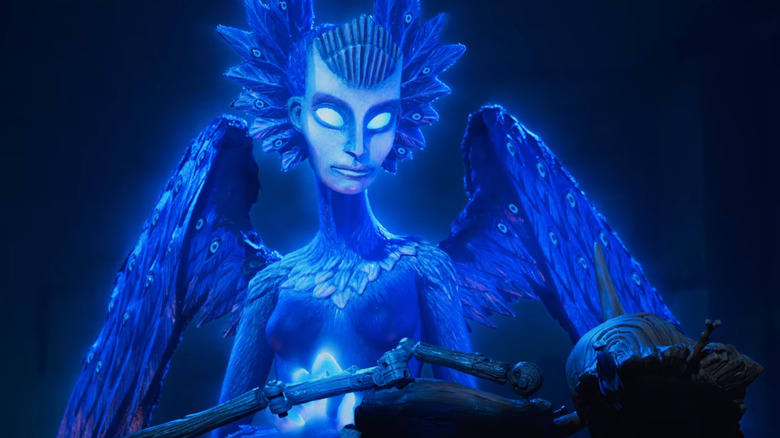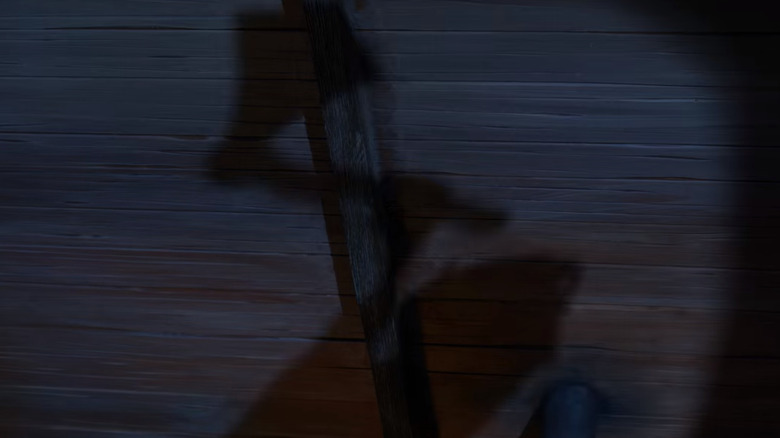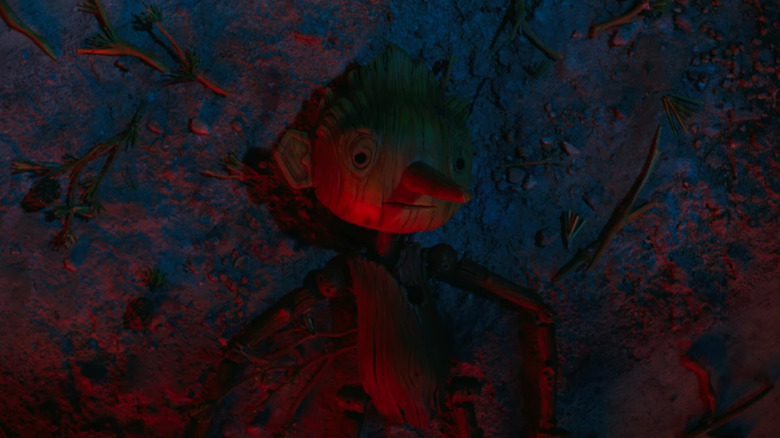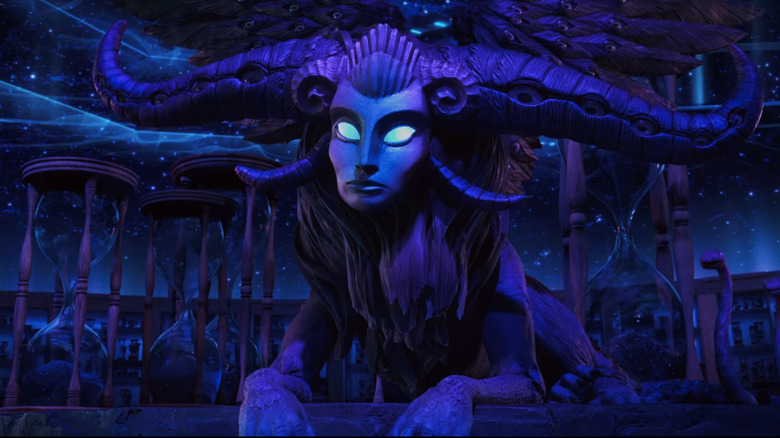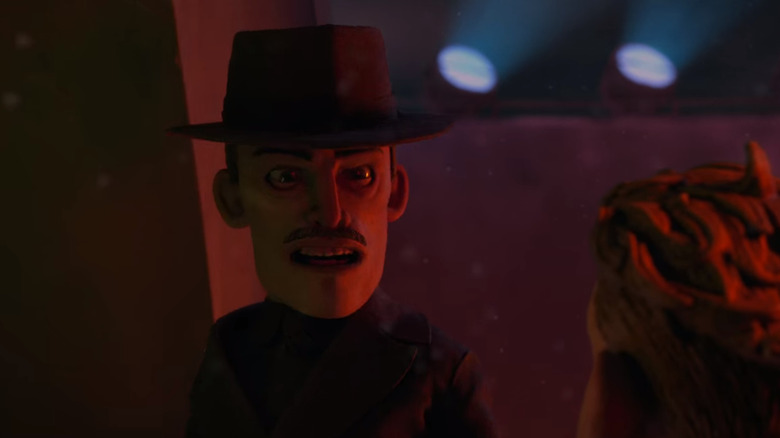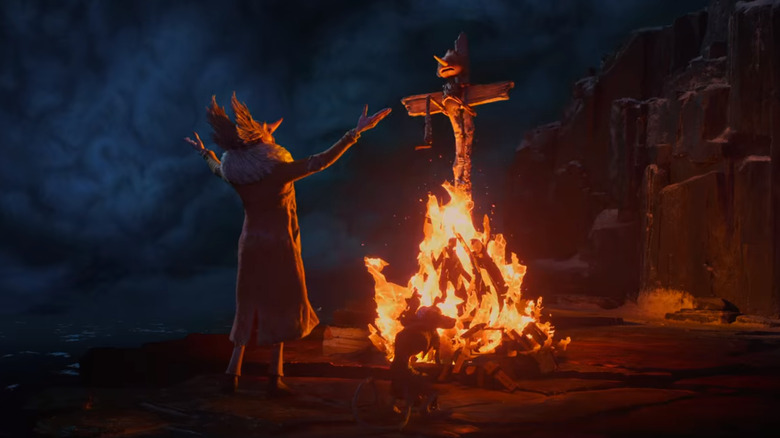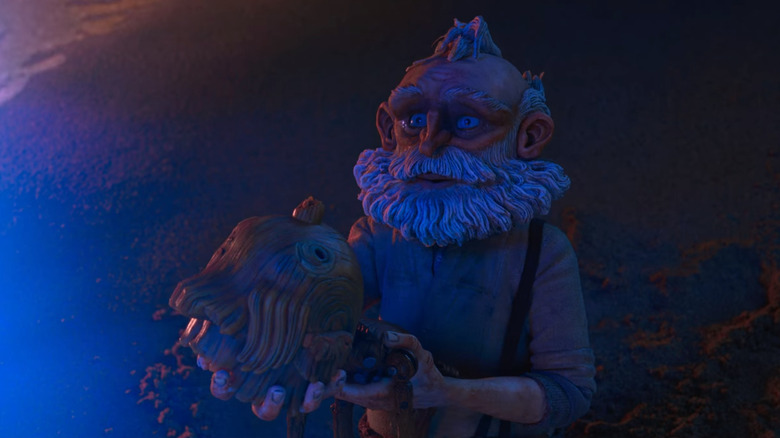Let's Talk About The Most Disturbing Moments In Guillermo Del Toro's Pinocchio
This article contains spoilers for "Guillermo del Toro's Pinocchio."
No one expected "Guillermo del Toro's Pinocchio" to be a lighthearted romp, given that it's set in fascist Italy and the director is known for dark fairy tales. Still, there are some moments in the Netflix film that might make audiences wonder if it's really a kids' movie at all. It has all of the hallmarks of a children's film, including musical segments ready-made for singalongs and comical sidekicks like Sebastian J. Cricket (Ewan McGregor) and Spazzatura (Cate Blanchett), but it's also occasionally a little dark. Like, Pinocchio dies multiple times and hangs out with the personification of Death levels of dark. It's all in service of a beautiful, touching story about life being precious precisely because it ends, but it all might be a bit too much for the youngest or most sensitive viewers.
Del Toro set out to create a totally different kind of Pinocchio story, and his adaptation of the original 1881 novel by Italian satirist Carlo Collodi is unlike any other "Pinocchio" you'll ever see. Even characters who are supposed to be somewhat comforting, like the Wood Sprite that's this film's blue fairy, are a little unsettling to look at. "Guillermo del Toro's Pinocchio" is beautiful, but audiences should be prepared to watch at least a few scenes peeking from behind their fingers.
A brutal prologue
The movie starts with a bit of backstory, as Geppetto (voiced by David Bradley) suffers an extraordinary loss when his young son Carlo is killed when an errant bomb lands on their church during the events of World War I. Geppetto buries his son and a pine cone that the boy was excited about, and as the tree grows, the carpenter seems to waste away. One night he gets drunk by his son's grave and chops down the pine tree, now home to Mr. Cricket, then carves it into a little wooden boy. Pinocchio's creation isn't a thing of wonder, but one of drunken horror as Geppetto hacks and slices away at the chunks of wood. Sebastian watches from a safe perch on a cuckoo clock as the carpenter wreaks havoc on his home, often in silhouette like a sadistic ax murderer.
When Geppetto is done, he passes out unceremoniously in a corner and the Wood Sprite makes her visitation to bring the little wooden boy to life. The opening of the movie jumps from a heartbreaking sequence to rival the opening of Pixar's "Up" followed by an unhinged "Frankenstein"-esque creation scene. This ain't your grandma's "Pinocchio."
Pinocchio's first death
Things go alright for Pinocchio (voiced by Gregory Mann) for a little while after his unconventional "birth," and he brings a lot of light and joy into Geppetto's life. The problems start when Pinocchio gets the attention of the local townspeople, including fascist government official Podesta (voiced by Ron Perlman). Podesta worries about what influence the spirited wooden boy might have on the impressionable youth of the town, and suggests that he could be a dangerous element that inspires bad behavior. Pinocchio and Geppetto have a bit of a spat over Pinocchio's behavior, and he ends up in the middle of the road, where he gets run down by Podesta's truck.
The audience gets to see Pinocchio's little broken body lying in the dirt, lit by the red brake lights on Podesta's vehicle, and it's genuinely disturbing. Pieces of him have broken off and it's clear that there's no longer any life left within him. It's traumatic stuff, and only continues to get stranger and darker as Pinocchio travels to the land of the dead.
Death and the realm of the dead
Pinocchio ends up carried down to the underworld by the seriously cool-looking Black Rabbits — basically, the world's cutest but creepiest pallbearers — to meet their master, Death. Death, voiced by Tilda Swinton, is a haunting creature that draws clear inspiration from both sphinxes and chimeras, with a lion's mane, feminine human face, goat horns, and snakes instead of tails. Like her sister, the Wood Sprite, she is covered with eyeballs, hearkening back to Guillermo del Toro's Angel of Death design from "Hellboy II." The eyes all over the wings of the Wood Sprite and Death's horns are reminiscent of the descriptions of biblical angels, which fits with the director's regular use of Catholic imagery starting all the way back in "The Devil's Backbone."
Death is surprisingly warm and kind despite being, you know, Death, but her realm is still pretty creepy and her warnings are appropriately ominous. She explains to Pinocchio that he can die many times and will have to wait longer to return to life each time, but that eventually he will simply wait, with her, forever. That's a bit of an existential mind-blower even for an adult, so no wonder poor Pinocchio doesn't quite grasp the gravity of the situation when he returns to life once more.
Training for war instead of going to Pleasure Island
Things stay kind of silly for a little bit, relatively speaking, as Pinocchio joins up with the circus, run by the villainous Volpe (Christoph Waltz), in order to earn money for his father and avoid being drafted to fight for Mussolini. The circus isn't exactly the happiest place in the world, but Pinocchio manages to make a sort of friend in Volpe's monkey Spazzatura, and it's still a circus! When Pinocchio is taken to perform for Mussolini himself, things get dark again because the little wooden boy with a heart of gold performs a rude, rebellious song that gets him summarily executed. When he comes back to life, he's being taken by Podesta to learn how to fight for the fascist regime with other young boys, including Podesta's own son, Candlewick (voiced by Finn Wolfhard).
In the original novel and the animated Disney adaptation, this is close to the part of the story where Pinocchio and his friends go to Pleasure Island, where they drink and gamble and are turned into donkeys. Instead of being turned into beasts of burden, the boys are trained to kill instead. Once more, Pinocchio makes a friend, this time in Candlewick, but the training camp is soon bombed and Podesta dies right in front of his son.
Pinocchio almost gets burned at the stake
Pinocchio goes from the frying pan to the fire, almost literally, as he is blown away from the fort where he was training and ends up with Volpe. Volpe's furious about the whole "embarrassing him in front of Mussolini" thing, and he ties Pinocchio to a cross and lights the base on fire. Just keep repeating to yourself: this is a kid's movie. This is a kid's movie.
The little wooden boy is saved once more by someone he's built a friendship with, as Spazzatura steps in to rescue Pinocchio from the flames and knock Volpe to his death. Free from worrying about fascist regimes or angry circus owners, Pinocchio is left to contend only with the ocean and the massive Dogfish that swallows him up. The good news is that he's reunited with Geppetto and Sebastian deep inside the belly of the fish, but their escape ends with Pinocchio dead once more and Geppetto headed towards certain doom.
A heartbreaking sacrifice
Pinocchio meets once more with Death, and he begs her to send him back immediately so he can save his father. She explains that he can go back and he might be able to save Geppetto, but if he does, he will be made mortal. She warns him that he will almost certainly die, and it would be permanent this time, but he chooses to take that chance. He ends up saving Geppetto but dies in the process, leaving the poor man weeping over the lifeless body of his second son. The Wood Spirit returns and Sebastian trades the one wish he earned from her to bring Pinocchio back to life one last time, but watching a man beg for his child to be brought back to life is rough. It all works out in the end, sort of, as the family is reunited and are able to live happily together until the end of their days.
Del Toro wasn't content to end the story with "happily ever after," however, and Pinocchio outlives Geppetto, Sebastian, and even Spazzatura before going out into the world on his own, where he might die, someday. It's a lovely sentiment about how precious each moment can be, because it could be our last, but it's one tear-jerker of an ending. If you can look at a pine cone without getting a little teary-eyed after watching "Guillermo del Toro's Pinocchio," you might be dead inside.
"Guillermo del Toro's Pinocchio" is now streaming on Netflix.
